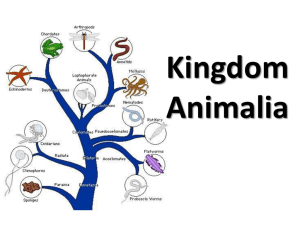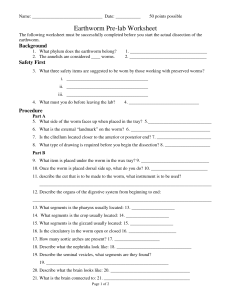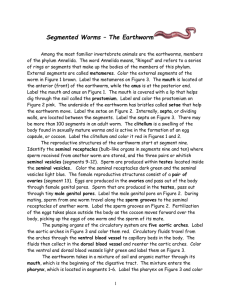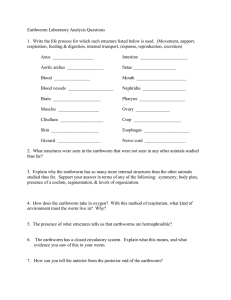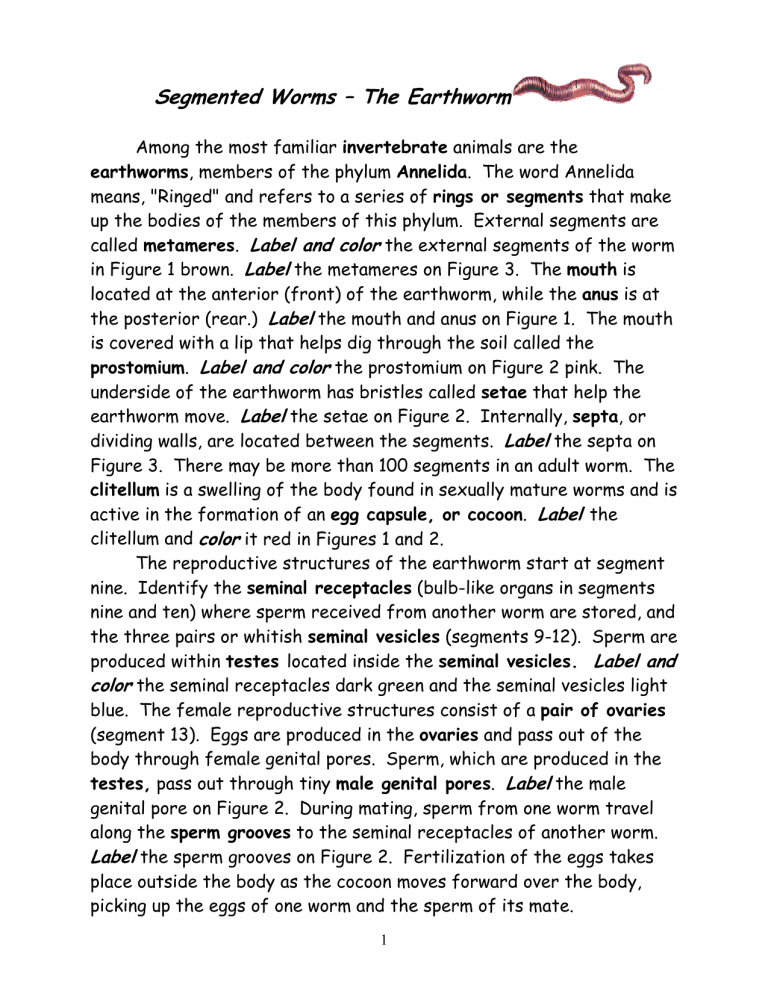
Segmented Worms – The Earthworm Among the most familiar invertebrate animals are the earthworms, members of the phylum Annelida. The word Annelida means, "Ringed" and refers to a series of rings or segments that make up the bodies of the members of this phylum. External segments are called metameres. Label and color the external segments of the worm in Figure 1 brown. Label the metameres on Figure 3. The mouth is located at the anterior (front) of the earthworm, while the anus is at the posterior (rear.) Label the mouth and anus on Figure 1. The mouth is covered with a lip that helps dig through the soil called the prostomium. Label and color the prostomium on Figure 2 pink. The underside of the earthworm has bristles called setae that help the earthworm move. Label the setae on Figure 2. Internally, septa, or dividing walls, are located between the segments. Label the septa on Figure 3. There may be more than 100 segments in an adult worm. The clitellum is a swelling of the body found in sexually mature worms and is active in the formation of an egg capsule, or cocoon. Label the clitellum and color it red in Figures 1 and 2. The reproductive structures of the earthworm start at segment nine. Identify the seminal receptacles (bulb-like organs in segments nine and ten) where sperm received from another worm are stored, and the three pairs or whitish seminal vesicles (segments 9-12). Sperm are produced within testes located inside the seminal vesicles. Label and color the seminal receptacles dark green and the seminal vesicles light blue. The female reproductive structures consist of a pair of ovaries (segment 13). Eggs are produced in the ovaries and pass out of the body through female genital pores. Sperm, which are produced in the testes, pass out through tiny male genital pores. Label the male genital pore on Figure 2. During mating, sperm from one worm travel along the sperm grooves to the seminal receptacles of another worm. Label the sperm grooves on Figure 2. Fertilization of the eggs takes place outside the body as the cocoon moves forward over the body, picking up the eggs of one worm and the sperm of its mate. 1 The pumping organs of the circulatory system are five aortic arches. Label the aortic arches in Figure 3 and color them red. Circulatory fluids travel from the arches through the ventral blood vessel to capillary beds in the body. The fluids then collect in the dorsal blood vessel and reenter the aortic arches. Color the ventral and dorsal blood vessels light green and label them on Figure 3. The earthworm takes in a mixture of soil and organic matter through its mouth, which is the beginning of the digestive tract. The mixture enters the pharynx, which is located in segments 1–6. Label the pharynx on Figure 3 and color the pharynx purple. The esophagus, in segments 6–13, acts as a passageway between the pharynx and the crop. The crop stores food temporarily. Label the esophagus in Figure 3 and color it violet. Label the crop in Figure 3 and color it yellow. The mixture that the earthworm ingests is ground up in the gizzard. Label the gizzard in Figure 3 and color it orange. In the intestine, which extends over two-thirds of the body length, digestion and absorption take place. Label the intestine in Figure 3 and color it brown. Soil particles and undigested organic matter pass out of the worm through the rectum and anus. The nervous system consists of the ventral nerve cord, which travels the length of the worm on the ventral side, and the brain, which is a series of ganglia at the anterior (head) end. Ganglia are masses of tissue containing many nerve cells. Label the brain on Figure 3 and color it peach. The nerve collar surrounds the pharynx and consists of ganglia above and below the pharynx. Nervous impulses are responsible for movement and responses to stimuli. Each segment contains an enlargement, or ganglion, along the ventral nerve cord. Excretory functions are carried on by nephridia, which are found in pairs in each body segment. Label the nephridia on Figure 3 and color it dark blue. They appear as tiny white fibers on the dorsal body wall. The earthworm has NO gills or lungs. Gases are exchanged between the circulatory system and the environment through the moist skin. 2 LABEL AND COLOR ALL DRAWINGS! Figure 1 Figure 2 3 Figure 3 Questions: 1. Name the parts of the earthworm's digestive system in order staring with the prostomium. 2. Earthworms are hermaphrodites. What does this mean? 3. Do earthworms fertilize their own eggs? Explain your answer. 4. Do earthworms have a closed or open circulatory system? Explain your answer. 4 5. What serves as "hearts" for the earthworm's circulatory system? 6. What is the purpose of a cocoon in earthworms? 7. What is the difference between seminal receptacles and seminal vesicles in earthworms? 8. Why is an earthworm considered as an annelid? 9. What is the difference between metameres and septa? 10. What helps an earthworm dig through the soil and where is this located? 11. What structures help an earthworm move through the soil and where are they located? 12. Name the parts of the nervous system of an earthworm. 13. What is the purpose of nephridia? 14. Where does digestion and absorption take place in an earthworm? 15. How does an earthworm breathe? 5
